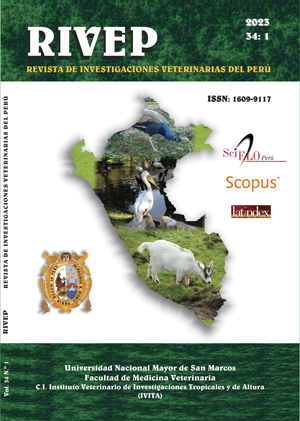Anthelmintic resistance in sheep farms of the warm valley of Alto Magdalena - Tolima
DOI:
https://doi.org/10.15381/rivep.v34i1.24591Keywords:
fenbendazole, ivermectin, levamisole, nematode, nematicidesAbstract
The aim of this study was to determine the degree of anthelmintic resistance of nematodes that affect sheep production in the warm valley of Alto Magdalena in the department of Tolima, Colombia, using the faecal egg count reduction technique. The study was carried out with 380 sheep in 13 farms. The load of gastrointestinal parasites was determined using the McMaster technique. Sheep with >200 eggs per gram of faeces were randomly assigned to four anthelmintic groups (fenbendazole, moxidectin, ivermectin, and levamisole) and one control group. Samples were collected on day 0 and day 14 postdosing to determine the percentage of drug effectiveness. In addition, larval cultures were performed to determine the species of nematodes present. Anthelmintic resistance was found, especially to Haemonchus spp in 91, 89 and 46% of the farms towards fenbendazole, ivermectin and levamisole, respectively, the most widely used compounds in the region, as well as multi-resistance in 78% of the farms.
Downloads
Downloads
Published
Issue
Section
License
Copyright (c) 2023 Gisella Karina Holguín-Céspedes, Edgar Díaz-Rivera

This work is licensed under a Creative Commons Attribution 4.0 International License.
AUTHORS RETAIN THEIR RIGHTS:
a. Authors retain their trade mark rights and patent, and also on any process or procedure described in the article.
b. Authors retain their right to share, copy, distribute, perform and publicly communicate their article (eg, to place their article in an institutional repository or publish it in a book), with an acknowledgment of its initial publication in the Revista de Investigaciones Veterinarias del Perú (RIVEP).
c. Authors retain theirs right to make a subsequent publication of their work, to use the article or any part thereof (eg a compilation of his papers, lecture notes, thesis, or a book), always indicating the source of publication (the originator of the work, journal, volume, number and date).










